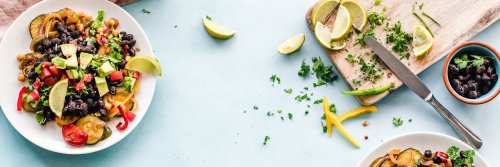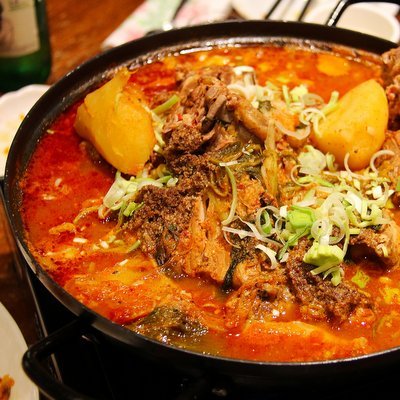The wonderful and unique state of Oaxaca is often referred to as the ‘Land of Seven Moles,’ even though the city of Puebla—east-central Mexico—is regarded as the birthplace of this irresistible sauce that will have you drooling over your food whether it's an enchilada, taco, burrito, or added to meat, beans, rice or vegetables. It's a Mexican iconic culinary triumph with now over 200 varieties of recipes primarily based on the staples of spices, nuts, chiles, and additions such as chocolate—used as either a marinade or a sauce showcasing nutty, rich, and earthy flavors.
The quirky nickname 'Land of Seven Moles' is based on the fact that the culinary region of the state of Oaxaca, which has seven regions, have each created seven spicey mole sauces unique to their own area: coloradito, verde, negro, rojo, manchamantel, chichilo, and Amarillo.

In Mexico, the food culture is so diverse and rich that in 2010, UNESCO honored Mexico by putting it on the list of Intangible Cultural Heritage of Humanity, exclusively because of its food. From its heirloom varieties of corn—the basis of its food traditions, to the country's unique farming methods, cooking processes, and distinctive utensils (grinding stones). Mexico's traditional cuisine is laden with symbolic meaning, such as the food offerings for the festival 'The Day of the Dead.'
Some say the best food is to be found in Mexico City. Still, many prefer the delights in Oaxaca, where tastes have morphed over centuries from its indigenous beginnings to the present day. The Oaxaca state is believed to be the most ethnically diverse of the thirty-one states in Mexico due to its mountainous landscape, wherein different tribal groups flourished and maintained their own cultures, languages, and traditions. Oaxaca's culinary history, with its Mixtec and Zapotec nuances found in its snacks sold all over the city streets, will give you many mouthfuls of the state's long ago saga.
Memelas
Shove a memelas in your mouth for breakfast—similar to a sope that’s made from corn flour in the shape of a cup—a memelas is a toasted thick ‘masa’ cake grilled on a flat round griddle to ensure its crispy and topped with various ingredients such as refried black beans, mole negro, shredded chicken, potatoes, salsa, and maybe shredded cabbage.
Tetelas
If you want heaps of topping on top of a treat, more so than on a memelas, bite into a tetelas, but ensure that you have somewhere to sit down as this is not a food to eat on the go due to its melty hot crema. It's a large corn tortilla cooked on a traditional griddle (aka comal) laden with refried black beans, crema, fresh cheese (queso fresco), and whatever else your stomach is grumbling to put on it. This parcel of lusciousness is folded into a triangle before being eaten. The hot dribbles will happen when trying to gobble it up, despite being folded.
Tlayudas
The tastiest ones can be found at local markets around the city, or head thirty minutes out of town to one of the oldest markets in the Americas at Tlacoulula. Somewhat similar to a pizza, the toppings of your choice are placed on a huge crispy corn tortilla smothered in 'asiento' (unrefined pork lard), fresh and stringy queso fresco (cheese), lettuce, tomato, and, of course, refried beans. Then, conjure up your list of additions: chorizo, chicken, or thinly sliced beef.

Oaxacan Empanadas
A small parcel of heaven—you will smell them before you see empanadas being cooked on a griddle in the streets. The perfect walkabout food, it's an oval corn tortilla stuffed with tasty morsels and folded in half. Fillings include mole, meats, cheese, or a particular vendor's specialty, like an empanada de Amarillo (spicy) or an empanada con flor de calabaza y quesillo (squash blossoms and cheese).
Chapulines
Not for the faint-hearted. Chapulines are the potato chips of the city—in fact, they aren't potatoes at all but grasshoppers! You can tuck into a bowl of spicy, garlicky crunch at any street vendor's establishment and munch your way around the streets and alleys.
Tamales Oaxaqueños
Not all tamales are equal. Run past the tamale stall and head to one selling Tamales Oaxaqueños steamed in banana leaves, not corn husks. Choose one with mole paired with turkey, pork, or chicken and experience the greatness of this humble treat.
Tejate
A taste of history in a frothy drink dating back to the Zapotec and Mixtec people of pre-Hispanic Mexico. A street specialty that can be bought from local women at food markets, who put their arms into massive clay bowls of white frothy liquid to scoop it out. It won't entice you with the look of it, as it's a paste of toasted maize flour, cacao beans, mamey fruit pits, and a white flower named flor de cacao—but it has nutty and floral flavors and is surprisingly good to drink.
In between feasting and snacking, work some of the calories off by strolling around the vibrant city streets that's a cultural hub, discover the mountains by biking, hiking, or horse riding, and travel over rugged mountains to the white sandy beaches on its coastline where the Pacific Ocean pounds its shores creating a mecca for surfers and picturesque seaside villages. You don't have to go home ten pounds heavier!
Gail Palethorpe, a self proclaimed Australian gypsy, is a freelance writer, photographer and eternal traveller. Check out her website Gail Palethorpe Photography and her Shutterstock profile.















